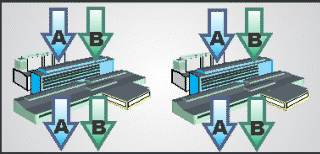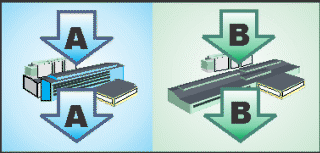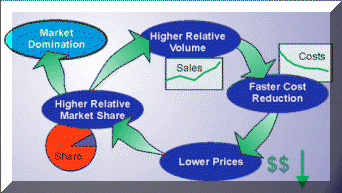Learning & Experience Curves
Implications for Marketing & Manufacturing
Focused Factories

Figure 1 Unfocused Factories

Figure 2 Focused Factories
When Wickham SKINNER wrote his seminal article on The Focused Factory, he was observing one effect of the Experience Curve. Any work unit, whether factory, workcell or company, will learn attain a higher learning rate when their range of products, processes and problems is narrower.
In figure 1, two identical factories each build two separate products. In figure 2, each factory focuses on only one of the two products. The complexity is cut in half and volume doubles. This increases the velocity in learning and reduced complexity enhances the learning rate.
Other factors such as freight costs or delivery time may outweigh the advantages of learning, focus and reduced complexity. Such situations should be analyzed carefully and defined in a firm's Manufacturing Strategy Statement.
The principle of focused factories can be extended to smaller-scale work units within the factory. To the extent that sales volume justifies it, production within a factory should be focused on particular products or product families. This usually takes the form of workcells and dedicated flow lines with a few functional areas (such as painting).

Learning & Experience Curve Synopsis
- For each doubling of total volume or repitition, cost, labor and other inputs decline by a fixed percentage.
- Many factors, including management attention, determine the specific "learning rate".
- The concept applies across a wide range of activities and organizations from individuals to entire industries.
- The reductions are consistent over long time periods of years or decades.
- At the level of workcells and workstations future cost declines are predictable.
- Athe level of Companies and industries there are important implications for Marketing and Manufacturing Strategy.
Implications for Marketing Strategy
There are many links between Marketing and Manufacturing Strategies. Ideally, these should be consistent and well-thought-out. In this article we only address those links and issues that directly relate to Learning and Experience curves and with respect to a few generic marketing strategies.
Some marketing strategies rely on unique product design, advertising or product positioning to attract customers. Such strategies do not depend, in a primary way, on Manufacturing. Manufacturing must meet reasonable expectations for cost and delivery but does not require outstanding performance. Learning Curves still affect profitability and this will always be a concern for managers and stockholders. But lowest cost is not a prerequisite for the marketing strategy or company survival.
Price Leadership/Cost Minimization Strategies`
With this strategy a firm attempts to dominate their maket by offering products at or near the lowest price. This implies that the firm's cost is at or near the lowest cost in the industry. Hence, learning curve effects play a key role.
The Role of Market Share
Market share effects related to Learning and Experience Curves were discussed earlier. Figure 3 shows how these elements and consequences form a circular cycle that can lead to increasing market dominance. When the market share, relative to competitors, increases it brings increasing volume. The increased volume brings more learning and more cost reduction. If cost reductions are translated into lower prices, the lower prices bring even more volume and, eventually, market domination.
A firm that already leads its industry in market share must have a learning rate that brings cost reductions at least as fast as the reductions for competitors. If other firms have larger market share, the learning rate must be faster than those competitors in order to offset their cost and learning advantage. Without such learning rates, the strategy will eventually fail.
Making It Work--Other Aspects
A high learning rate is not enough, by itself, for successful Price Leadership. A successful Price Leadership strategy will probably require at least the following additional elements:
Leading Capacity Strategy
This refers to a capacity policy that puts capacity in place before market demand actually exists. To harvest the market share available from low prices, the product must be available when customers ask for it. Since capacity requires a finite time to put in place, a firm cannot simply wait until demand is certain.
High/Risky Capital Investment
The firm that employs a Price Leadership strategy must, usually, have the financial resources for and be prepared to make significant and, often risky, investments. Partly, this is the result of the necessity for a Leading Capacity Strategy. It is also because learning effects and cost reduction will partly depend on having the best available process technologies.
Aggressive Pricing
When cost goes down, management can use the savings to reduce prices. Or, management may use the savings to increase profit and provide immediate benefit to shareholders. Maintaining a Cost Leadership marketing strategy usually requires aggressive pricing to ensure the continuation of the circular cycle of figure 3.
Niche Strategies
Niche strategies allow smaller smaller firms to compete in markets that may be dominated by much larger firms with lower costs, greater resources and lower pricing. A niche strategy identifies smaller market segments that are often ignored by larger firms. It then develops a marketing mix that addresses unique needs and characteristics of that target market.
The needs of the target markets may or may not place unique demands upon manufacturing. These needs should be carefully analyzed and the means for meeting those special needs incorporated in the firm's Manufacturing Strategy. While low cost and other learning effects may not be critical to strategic success, it certainly helps profitability.
Innovation Strategies
Apple is the model for innovation strategies. The idea is to create innovative product designs that command a premium price. This can allow a relatively small firm to compete in the market and, possibly, create whole new markets.
A key element is having the capacity to meet initial customer demand when the new products are released. Without this capacity, sales will suffer, market share will not meet its potential and competitors have time to react. Therefore, a leading capacity strategy is essential and this strategy can be quite riskly because the size of the market and potential demand is unknown. Highly innovative products may need equally innovative process technologies for the manufacture. This must also be in place prior to new product launch and increases risk even further.
Learning Curve effects play a somewhat different role with innovation strategies. Of course, it is important to learn how to produce the product quickly and with high quality. In addition, there is a sort of second-order learning that should occur. The firm must learn how to develop, launch and manufacture new products quickly.
Fashion Strategies
Fashion strategies depend upon product design more than manufacturing capability. As the name implies, they involve the design of new variations for what is, essentially, a conventional product with conventional processes. The latest dress design may appear different than last year's model but the manufacturing process is the same.
Learning & Experience Curve Synopsis
- For each doubling of total accumulated volume or repitition, cost, labor and other inputs decline by a fixed percentage, often in the range of 5%-25%.
- Many factors, including management attention, determine the specific "learning rate".
- The concept applies across a wide range of activities and organizations from individuals to entire industries.
- The reductions are consistent over long time periods of years or decades.
- At the level of workcells and workstations future cost declines are predictable.
- Athe level of Companies and industries there are important implications for Marketing and Manufacturing Strategy.
References
HENDERSON, BRUCE D., "The Experience Curve – Reviewed II: History, 1973". Retrieved 2013-04-04.
HENDERSON, BRUCE D., The Experience Curve (Accessed October 17, 2014.
HILL, TERRY, Manufacturing Strategy, Macmillan, London, 1985.
LEE, QUARTERMAN, "How To Optimize Manufacturing Focus", Managing Technology Today, Vol. 1, No. 5, September/October, 1992.
LEE, QUARTERMAN, "Manufacturing Focus - A Comprehensive View", Operations Management Association (OMA) Conference Proceedings, Warwick, England, June, 1990.
SKINNER, WICKHAM, The Focused Factory, Harvard Business Review, May-June, 1974.
Wright, T.P., Factors Affecting the Cost of Airplanes, Journal of Aeronautical Sciences, 3(4) (1936): 122-128.

■ ■ ■ ■ ■ ■ ■



